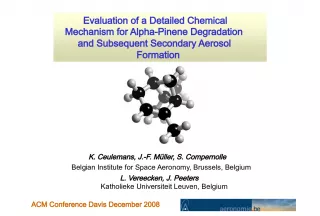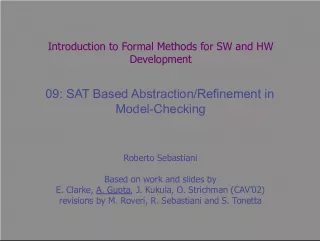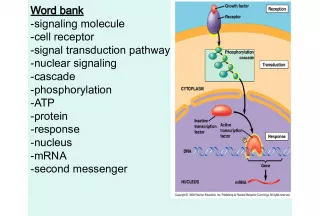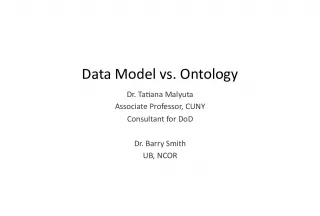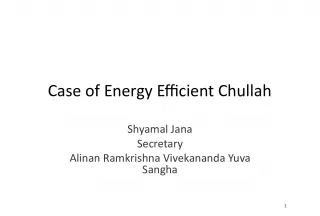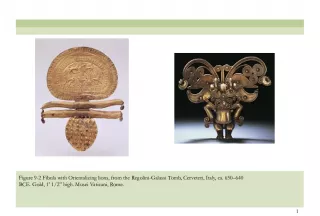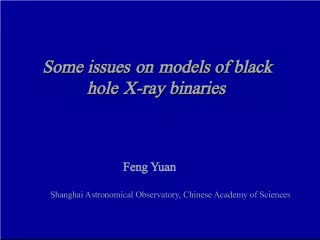"Model Pathways in the BOREAM BIOSOA Chemical Model"
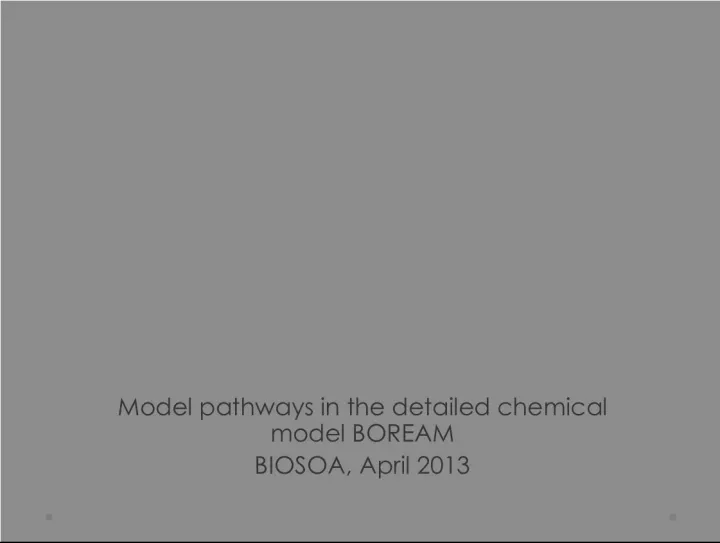

This article presents the BOREAM model for pinene and pinene SOA, developed in April 2013. The BOREAM model utilizes a primary
- Uploaded on | 1 Views
-
 janis
janis
About "Model Pathways in the BOREAM BIOSOA Chemical Model"
PowerPoint presentation about '"Model Pathways in the BOREAM BIOSOA Chemical Model"'. This presentation describes the topic on This article presents the BOREAM model for pinene and pinene SOA, developed in April 2013. The BOREAM model utilizes a primary. The key topics included in this slideshow are . Download this presentation absolutely free.
Presentation Transcript
Slide1Model pathways in the detailed chemicalmodel BOREAM BIOSOA, April 2013
Slide2BOREAM model BOREAM model • Model for α -pinene and β -pinene SOA • Primary chemistry: based on theoretical (quantum calculations) and experimental rates, SARs • Secondary chemistry: generated automatically based on SARs • Generic chemistry for not-explicitly treated species • Version for long-term SOA ageing: 65000 equations • Version for specific tracers: 21000 equations, but more detail on specific pathways • Update of photolysis rates currently underway
Slide3α-pinene + OH α -pinene + OH • Based on Peeters et al. (2001), Fantechi et al. (2002), Vereecken et al. (2007) • High-NO x : large pinonaldehyde yield • Low-NOx: multifunctional hydro-peroxides • Some unusual isomerisations of peroxy and alkoxy radicals (Vereeecken et al., 2007)
Slide4α-pinene + O 3 α -pinene + O 3 • Based on Fantechi et al. 2002, Capouet et al. 2008 • 2 Criegee intermediates • CI-1 leads to additional acids such as pinic, pinalic and hydroxypinonic acid
Slide5Pinonaldehyde + OH, photolysis Pinonaldehyde + OH, photolysis • Based on Fantechi et al. (2002) • Vereecken & Peeters (2002) for the OH H-abstraction rates
Slide6SOA ageing experiments SOA ageing experiments • Yasmeen et al. 2012, E0802 • Low-NO x • Initial α -pinene: 252 ppb • Initial O 3 : 1400 ppb, no OH-scavenger • First hour: dark ozonolysis and OH oxidation • After 1 hour: irradiation with solar-like spectrum for 219 minutes • Experimental SOA mass yield: 26% (assuming density 1 g/cm 3 , but ρ =1,32g/cm 3 would give 34,3%) • Model SOA mass yield: 43,5%
Slide7BOREAM modeled SOA Composition for E0802 in Yasmeen et al.2012 BOREAM modeled SOA Composition for E0802 in Yasmeen et al.2012 • Composition after 1 hour, before start irradiation • Pinic and pinonic acid: 7 and 6,5% of SOA • Many multifunctional hydroperoxides, dicarbonyl species
Slide8BOREAM Model concentrations for tracers in E0802 in Yasmeen et al. 2012 BOREAM Model concentrations for tracers in E0802 in Yasmeen et al. 2012 Name BOREAM (ppt) 8-Hydroxypinonic acid 29 10-Hydroxy pinonic acid 210* Diaterpenylic acid 53 Norpinic acid 11 Terpenylic acid 0.003** Diaterpenylic acid acetate < 0.001** MBTCA (conventional chem.) < 0.001 MBTCA (pinonic acid direct pathway, Müller et al. 2012) 2.8 M172 (keto-diol) 1298 *A direct, but mechanistically unresolved formation of 2% of 10-hydroxypinonic acid from CI-1 was added in BOREAM, together with 10% pinalic acid and 6% pinic acid, based on Yu et al (1999) . This production is not included in this value, which represents all explicit resolved pathways in the current mechanism. ** A newly proposed pathway for ester formation from an alkoxy radical could potentially lead to several 10s of ppt of terpenylic acid and diaterpenylic acid acetate from pinonic acid. A similar pathway might perhaps be present in the pinonaldehyde mechanism, although there it would need to compete against a fast 1,5-H.shift
Slide910-hydroxy pinonic acid and 8-hydroxy pinonic acid 10-hydroxy pinonic acid and 8-hydroxy pinonic acid • 10-hydroxy pinonic acid: Main pathway through the hydroperoxide channel of CI-1 (0.207 ppb) • Pinonic pathway is minor • 8-hydroxy pinonic acid: pathway from pinonic acid leads to 0.0294 ppb
Slide10Diaterpenylic acid Diaterpenylic acid • Main pathway through the minor (21%) hydroperoxide radicalar channel from CI-1 • Main bottlenecks: 2 times reaction of acyl peroxy radical with HO 2 or RO 2 to form carboxylic acid (each 10-fold reduction of reaction flow)
Slide11Norpinic acid Norpinic acid • Low model yield (10 ppt), mainly from pinalic acid OH- oxidation • Main bottleneck: OH-oxIdation of pinalic acid, with a reduction of 60 of the reaction flow • Pinic acid oxIdation gives only a minor contribution, due to slow OH oxIdation, as it’s mainly in the SOA
Slide12Terpenylic acid: conventional gas phase chemistry Terpenylic acid: conventional gas phase chemistry • Very low yield of 0.0026 ppt • Unfavourable competition from peroxy radical ring- closure isomerisation for the formation of the sy-alkoxy radical • Required OH- oxydations are too slow for duration of experiment • Only 10-15% branching towards carboxylic acid for acyl peroxy radicals
Slide13Diaterpenylic acid acetate: conventional gas phase chemistry Diaterpenylic acid acetate: conventional gas phase chemistry • Extremely low yield of 0.00047 ppt • Similar bottlenecks as for terpenylic acid: • Unfavourable competition from peroxy radical ring-closure isomerisation for the formation of the sy- alkoxy radical (low-NO x ) • Required OH-oxydations are too slow for duration of experiment • Only 10-15% branching towards carboxylic acid for acyl peroxy radicals (2 times)
Slide14MBTCA: “forced” direct pathway from Müller et al. 2012 MBTCA: “forced” direct pathway from Müller et al. 2012 • 1% yield from pinonic acid experimentally • Conventional gas phase chemsitry: requires about 3 to 4 subsequent OH oxidations • Unfavorable carboxylic acid yields • Proposed pathway by L.Müller et al. requires 3 probably very unlikely steps • Even then yields are low due to slow pinonic acid oxidation
Slide15M172 product (dinorpinic acid) M172 product (dinorpinic acid) • Difficult to find conventional pathway, as removal of a methyl group normally leads to replacement by an oxygenated group (H-shifts for alkyl radicals are unlikely) • Other product with nearly identical mass, but 9 carbons is present in high yield
Slide16Alternative pathway towards terpenylic acid and diaterpenylic acid acetate Alternative pathway towards terpenylic acid and diaterpenylic acid acetate • Involves alkoxy radical ester formation • Proposed by J. Dommen et al. to explain acetate in CMK photo-oxidation (Praplan et al. 2012) • Probably exothermal • Probably energy barrier comparable to acetone elimination • No quantum calculations yet
